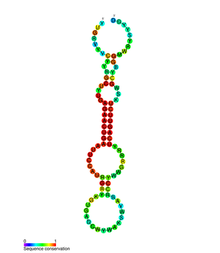MiR-146
Today, MiR-146 has become a topic of great interest and relevance in different areas of society. Whether in the world of technology, politics, health or culture, MiR-146 has managed to capture the attention of millions of people around the world. Its impact and significance are reflected in the numerous investigations, debates and discussions that revolve around it. That is why in this article we will thoroughly explore the importance and implications of MiR-146 today, analyzing its role in different contexts and providing a complete overview of its relevance in today's society.
| miR-146 | |
|---|---|
 Conserved secondary structure of miR-146 microRNA precursor | |
| Identifiers | |
| Symbol | miR-146 |
| Alt. Symbols | MIR146 |
| Rfam | RF00691 |
| miRBase | MI0000477 |
| miRBase family | MIPF0000103 |
| NCBI Gene | 406938 |
| HGNC | 31533 |
| OMIM | 610566 |
| RefSeq | NR_029897 |
| Other data | |
| RNA type | miRNA |
| Domain(s) | Mammalia |
| GO | 0035195 |
| SO | 0001244 |
| Locus | Chr. 5 q34 |
| PDB structures | PDBe |
miR-146 is a family of microRNA precursors found in mammals, including humans. The ~22 nucleotide mature miRNA sequence is excised from the precursor hairpin by the enzyme Dicer.[1] This sequence then associates with RISC which effects RNA interference.[2]
miR-146 is primarily involved in the regulation of inflammation[3] and other process that function in the innate immune system.[4] Loss of functional miR-146 (and mir-145) could predispose an individual to suffer from chromosome 5q deletion syndrome.[5] miR-146 has also been reported to be highly upregulated in osteoarthritis cartilage, and could be involved in its pathogenesis.[6] mir-146 expression is associated with survival in triple negative breast cancer.[7]
Function
miR-146 is thought to be a mediator of inflammation along with another microRNA, mir-155. The expression of miR-146 is upregulated by inflammatory factors such as interleukin 1 and tumor necrosis factor-alpha.[8] miR-146 dysregulates a number of targets which are mostly involved in toll-like receptor pathways that bring about a cytokine response as part of the innate immune system.[4][8] miR-146 operates in a feedback system or "negative regulatory loop"[9] to finely tune inflammatory responses.[5]
Applications
miR-146 could be used as a biomarker for sepsis.[10] In addition it was found to be absent from the exosomes of prion infected cells suggesting it could be used as a biomarker for prion infection.[11] miR-146a could be targeted therapeutically as its depletion has implication in the hyperactive response to infection.[12]
References
- ^ Ambros V (Dec 2001). "microRNAs: tiny regulators with great potential". Cell. 107 (7): 823–6. doi:10.1016/S0092-8674(01)00616-X. PMID 11779458. S2CID 14574186.
- ^ Gregory RI, Chendrimada TP, Cooch N, Shiekhattar R (Nov 2005). "Human RISC couples microRNA biogenesis and posttranscriptional gene silencing". Cell. 123 (4): 631–40. doi:10.1016/j.cell.2005.10.022. PMID 16271387. S2CID 16973870.
- ^ Baechle JJ, Chen N, Winer DA (2023). "Chronic inflammation and the hallmarks of aging". Molecular Metabolism. 74: 101755. doi:10.1016/j.molmet.2023.101755. PMC 10359950. PMID 37329949.
- ^ a b Sonkoly E, Ståhle M, Pivarcsi A (Apr 2008). "MicroRNAs and immunity: novel players in the regulation of normal immune function and inflammation". Seminars in Cancer Biology. 18 (2): 131–40. doi:10.1016/j.semcancer.2008.01.005. PMID 18291670.
- ^ a b Quinn SR, O'Neill LA (Jul 2011). "A trio of microRNAs that control Toll-like receptor signalling". International Immunology. 23 (7): 421–5. doi:10.1093/intimm/dxr034. PMID 21652514.
- ^ Yamasaki K, Nakasa T, Miyaki S, Ishikawa M, Deie M, Adachi N, Yasunaga Y, Asahara H, Ochi M (Apr 2009). "Expression of MicroRNA-146a in osteoarthritis cartilage". Arthritis and Rheumatism. 60 (4): 1035–41. doi:10.1002/art.24404. PMC 2670476. PMID 19333945.
- ^ Lánczky A, Nagy Á, Bottai G, Munkácsy G, Szabó A, Santarpia L, Győrffy B (2016-12-01). "miRpower: a web-tool to validate survival-associated miRNAs utilizing expression data from 2178 breast cancer patients". Breast Cancer Research and Treatment. 160 (3): 439–446. doi:10.1007/s10549-016-4013-7. ISSN 1573-7217. PMID 27744485. S2CID 11165696.
- ^ a b Sheedy FJ, O'Neill LA (Dec 2008). "Adding fuel to fire: microRNAs as a new class of mediators of inflammation". Annals of the Rheumatic Diseases. 67 (Suppl 3): iii50-5. doi:10.1136/ard.2008.100289. PMID 19022814. S2CID 20802154.
- ^ Ma X, Becker Buscaglia LE, Barker JR, Li Y (Jun 2011). "MicroRNAs in NF-kappaB signaling". Journal of Molecular Cell Biology. 3 (3): 159–66. doi:10.1093/jmcb/mjr007. PMC 3104013. PMID 21502305.
- ^ Gîză DE, Vasilescu C (Sep–Oct 2010). "". Chirurgia (Bucur.). 105 (5): 625–30. PMID 21141085.
- ^ Bellingham SA, Coleman BM, Hill AF (Nov 2012). "Small RNA deep sequencing reveals a distinct miRNA signature released in exosomes from prion-infected neuronal cells". Nucleic Acids Research. 40 (21): 10937–49. doi:10.1093/nar/gks832. PMC 3505968. PMID 22965126.
- ^ O'Connell RM, Rao DS, Baltimore D (2012). "microRNA regulation of inflammatory responses". Annual Review of Immunology. 30: 295–312. doi:10.1146/annurev-immunol-020711-075013. PMID 22224773.
Further reading
- Okada H, Kohanbash G, Lotze MT (Aug 2010). "MicroRNAs in immune regulation--opportunities for cancer immunotherapy". The International Journal of Biochemistry & Cell Biology. 42 (8): 1256–61. doi:10.1016/j.biocel.2010.02.002. PMC 2889234. PMID 20144731.
- Jädersten M, Hellström-Lindberg E (May 2010). "New clues to the molecular pathogenesis of myelodysplastic syndromes". Experimental Cell Research. 316 (8): 1390–6. doi:10.1016/j.yexcr.2010.02.043. PMID 20211165.
- Chan EK, Ceribelli A, Satoh M (Apr 2013). "MicroRNA-146a in autoimmunity and innate immune responses". Annals of the Rheumatic Diseases. 72 (Suppl 2): ii90-5. doi:10.1136/annrheumdis-2012-202203. PMC 7664460. PMID 23253933. S2CID 35063994.
See also
External links